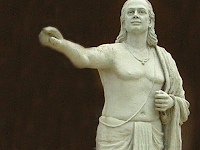Brahmadeva was an Indian
mathematician who wrote a commentary on the work of Aryabhata. He lived between
1060 and 1130 AD in the Mathura district of Uttar Pradesh.
Brahmadeva’s commentary is in nine chapters, and it
follows the contents of the original
work of aryabhata, including the longitudes of the planets, problems relating
to the daily rotation of the heavens, eclipses of the sun and moon, risings and
settings, the lunar crescent, and conjunctions of the planets.
Brahmadeva’s commentary, dealing partly with trigonometry
and its applications to astronomy, was particularly popular in madras, Mysore,
and Maharashtra.
Brahmadeva died at the age of 70,
but his reputation as a scientist, mathematician, astronomer, and academician
lives on.
TERMS
FOR NUMBERS
Bhaskaracharya
has given the terms for numbers in multiples of ten. They are eka(1),
dasha(10), shata(100), sahasra(1000), ayuta(10,000), laksha(100,000), prayuta(1,000,000=1 milion)
and so on.
 Bhaskaracharya considered
a genius
Bhaskaracharya considered
a genius
Bhaskaracharya was a genius
in mathematics, especially in algebra and geometry. He was born in sahyadri,
and headed the astronomical observatory in Ujjain.
Bhaskaracharaya also known as Bhaskara II(AD 1114-1183),
wrote six books on arithematic, algebra, trigonometry, calculus, geometry, and
astronomy. He suggested simple methods
to calculate the square, square roots,cube, and cube roots of big numbers.
The Pythagoras theorem was proved by him in only two
lines. Bhaskaracharya wrote about the gravitational force that helps to keep
the planets, the sun, and the moon in their respective orbits much before the
rest of the world even though about such an explanation. His work on calculus
predates newton and Leibniz by over half a millennium. He is particularly known
for the discovery of the principles of differential calculus, and its
application to astronomical problems and computations. His renowned works are ‘Lilavati’
and ‘Bijaganita’.


















.jpg)








